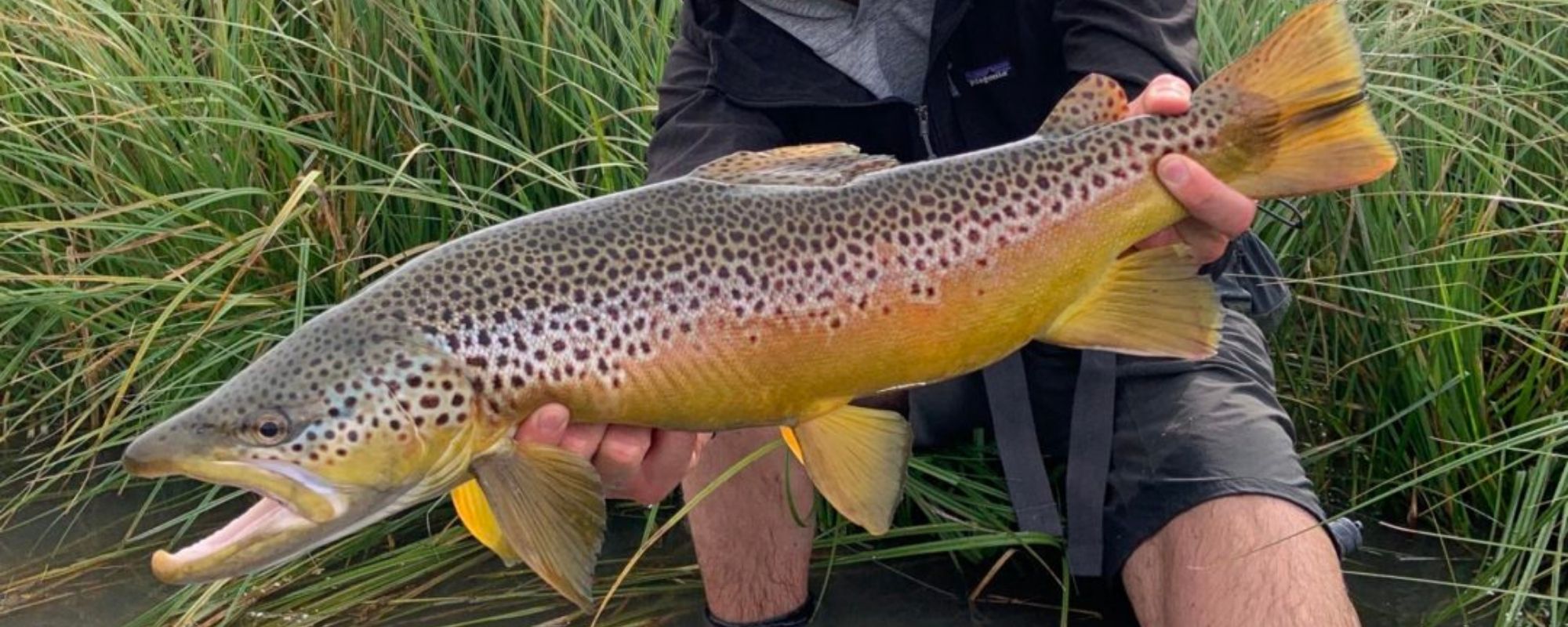
Brown Trout in Montana: Chasing the One
A good friend told me once that, as anglers, we are constantly chasing the “one fish” that makes us look back on the year and smile. For many of us that enjoy fly fishing in Montana, it’s landing that elusive, two-foot brown trout. Brown trout are one of the top predators in our river systems that can be fooled on a number of tactics, but honing in on several characteristics will increase your chances of landing that record-breaking fish. An understanding of the species, their behavior and where to find them is crucial in planning your next Montana fly fishing adventure.
Brown Trout History
Browns have an interesting history in Montana. Brown trout belong to a different genus than our native cutthroat species. Browns, along with rainbow trout, are non-native and were introduced in the 19th century. These populations were maintained until 1974, when, contrary to the opinions of many involved in Montana’s fisheries at the time, the state halted the stocking of the state’s rivers and streams. Since then, arguably the strongest wild populations of browns in the country have thrived in Montana. It’s rare to find the biodiversity and genetic purity in these populations anywhere else in the U.S. The average size of a Montana brown trout in our state’s rivers and streams can range anywhere from 12-20 inches. However, sometimes the stars align and a kyped-up buck brown in full golden regalia is brought to the net. Those are the moments you come to Montana for. Getting there, however, can be a maddening process.
Montana Brown Trout Characteristics

Brown trout share many characteristics of other cold water fish in Montana, yet have certain behaviors that make them unique. Generally speaking, Montana trout species require clean, cool flows in order to survive. Brown trout, however, tend to be a more tolerable species compared to native Montana species like westslope cutthroat or bull trout that require pristine conditions to thrive. That being said, trophy brown trout can be found in various water types depending on the time of year.
In the winter, trout pod up in deep, walking-speed water or under tight riffles in drop offs to expel the least amount of energy while feeding. Come spring, the increase in water in the system that precedes runoff from warmer temperatures gets brown trout moving around. In spring months, anglers can capitalize on early insect activity and scattered baitfish in high water to target big browns looking to gorge themselves after a long Montana winter.
Come summer time, big brown trout smash hoards of large stoneflies and sip mayflies all day long. When there is so much food in the system, identifying what big brown trout are keying in on can be difficult. A seasoned brown sees a lot of flies and can be selective when it comes to flies, presentation and feeding patterns. That is what makes catching big brown trout this time of year so special.
When summer fades and brown trout prepare to spawn, those trophy trout get aggressive. Brown trout that measure well over 20” can crush 5 inch streamers in very visual eats. If you are patient and can handle the dynamic Montana weather, then it’s likely you will be rewarded. In total, brown trout behave in a very unique and dynamic way depending on their habitat’s conditions, time of year, and food sources. Understanding the intersection of all these variables and how they affect your chances at fooling a Montana brown trout is the crux of our sport.
Tips and Tricks for Anglers

Anglers can catch big brown trout nymphing, throwing dry flies and stripping streamers. With this in mind, understanding some common themes in their feeding patterns can increase your chances when fishing with any of these tactics. There are many variables that anglers can focus on when targeting a trophy brown trout. However, keep in mind that a trophy brown trout is generally lazy and lethargic during the day. This sometimes means that bigger is not necessarily better. Trust me there, there is a time and place for a size 6 foam dry fly or a large Sex Dungeon. But they might not always be on the menu for big brown trout. A wary brown is looking for the easiest food option available without increasing their chances of predation. This often means they key in on plentiful nymphs or dry flies in the emerging or cripple stage. A well- placed cast with a dragless drift is also critical when fishing these flies. Imagine what it would be like to nip the fly off your leader and let it drift downstream. Mimicking that natural drift in your presentation can seal the deal.
“Matching the hatch” is a popular way to approach trout fishing in Montana. For the most part, all cold water species share similar diets. Brown trout, however, have been known to push the boundaries in prey in ways that have donned them nasty predators. All year long, this diet consists of aquatic insects, invertebrates, worms, and terrestrial insects like grasshoppers and beetles. Additionally, trout regularly prey upon small baitfish, sculpin, and other trout. Brown trout are known to be even more daring, often devouring mouse patterns and meaty streamers when the sun goes down. We like to carry a wide selection of various stages of these insects, colors and sizes in order to adapt to the conditions. Check out our fishing reports or give our shop a call to find out what they’re eating during your next fly fishing trip.
Best Brown Trout Fishing in Montana

Fortunately, some of the best rivers to find these fish are in our backyard. Plan your next Montana fly fishing trip with the Bitterroot, Blackfoot, Missouri, Madison and Beaverhead Rivers in mind. All of these rivers offer unique opportunities with excellent chances to get into big brown trout.
The Bitterroot River is one of our favorite brown trout rivers. It boasts astounding dry fly fishing in the spring and summer months, yet draws many to strip streamers for big browns in the fall. The Bitterroot is challenging yet inviting, and that’s why we love it so much! The Bitterroot is home to some of the earliest stonefly fishing of the year of anywhere in the West. Itching to fish big foam flies in early spring? Check out our most up-to-date Bitterroot River fishing report today!
With deep, cavernous runs and boiling riffles, the Blackfoot River is a sight to behold in the summer months. Swarms of salmon flies crawl into the willows and bomb the surface to lay their eggs in a dry fly bonanza in June. Big trout take advantage of this short window to feed on big, gawky stoneflies. Want to know what the Blackfoot is doing today? Check out our Blackfoot River fishing report for the latest updates.
The Missouri River is home to the most trout per mile in the state. It’s an incredible tailwater with abundant mayfly and caddis hatches all summer. Streamer fishing on the “MO” is very productive, as well. The MO offers a unique opportunity to catch big brown trout on small flies. Anglers can fish the MO all year long and catch big fish using various methods.
The Madison River has become a household name and for good reasons. This tailwater sustains large populations of brown and rainbow trout with insane hatches. From salmon flies to PMD’s, this river offers it all and can produce huge brown trout.
East of Bozeman, MT, the Yellowstone River provides another excellent opportunity to catch brown trout in southwest Montana. The Yellowstone offers a variety of fish to be caught from its headwaters in and around YNP to some of its most popular stretches in Paradise Valley.
Finally, the Beaverhead River south of Dillon, MT, is home to football size rainbow trout and big, buttery brown trout. For technical nymphing and dry fly fishing with big rewards, look no further. The Beaverhead is a tailwater that flows out of Clark Canyon Reservoir. These cold, controlled flows enable abundant insect hatches throughout the hot and dry summer, when other rivers may be restricted to fishing.
There is plenty to daydream about when it comes to fly fishing in Montana, more specifically catching that trophy brown trout. While they are certainly not the end all be all of fly fishing in our rivers, these fish hold a special place in our hearts. In addition to the six rivers listed, brown trout can be found across the state in various types of water. Give us a ring to discuss getting your hands on one of these trophy brown trout and discovering the best time to fly fish in Montana! And if you’re interested in getting the right fishing gear setup for your next solo or guided fishing trip, be sure to check out our online fly shop for all the essential fishing gear and more.
SHOP OUR ONLINE FLY SHOP
SHOP
WITH US
| Shop Online
Fish
WITH US
| Guided Fly Fishing Trips
stay
WITH US
| Lodging Packages
OUR NEWSLETTER
Sign Up For Our Newsletter & Receive 10% OFF Your Next Order
Join our mailing list for expert information on fly fishing, deals and discounts, and more information from our Missoula fly shop!
